Abstract
Objective:
The purpose of this study was to determine if individuals with unilateral functional ankle instability had decreased ability to maintain postural sway, as well as decreased isokinetic eccentric strength of ankle evertors and invertors.
Design and Setting:
Subjects with no previous history of ankle injury were compared with subjects with functional ankle instability on the following tests: isokinetic eccentric inversion and eversion strength and measures of single-limb postural sway.
Subjects:
Eighteen subjects participated in this study: 9 subjects in the functional instability (FI) group (age = 22.89 ± 3.18 yr, ht = 181 ± 6.0 cm, wt = 80.25 ± 12.2 kg) and 9 noninjured (NI) controls (age = 26.22 ± 2.34 yr, ht = 170 ± 10.0 cm, wt = 65.08 ± 12.03 kg).
Measurements:
Subjects performed postural sway assessment on a balance system under static and dynamic conditions. Ankle inversion and eversion eccentric strength were evaluated at 90°/sec using an isokinetic dynamometer. Additionally, we assessed the degree of mechanical instability in the FI group with a series of stress radiographs.
Results:
No significant differences in single-limb postural sway measures or in eversion strength between limbs in the FI group or between groups were found. A significant group-by-limb interaction was present in inversion peak torque; however, post hoc testing revealed the only difference to be between the dominant and nondominant limbs of the NI group.
Conclusions:
Postural sway and inversion and eversion eccentric peak torque are not affected by functional instability of the ankle. Alternate methods of postural sway assessment and ankle strength measurement are discussed as possible areas for future study.
Keywords: balance, peak torque, ankle sprain, joint position sense, proprioception, peroneal muscle
Full text
PDF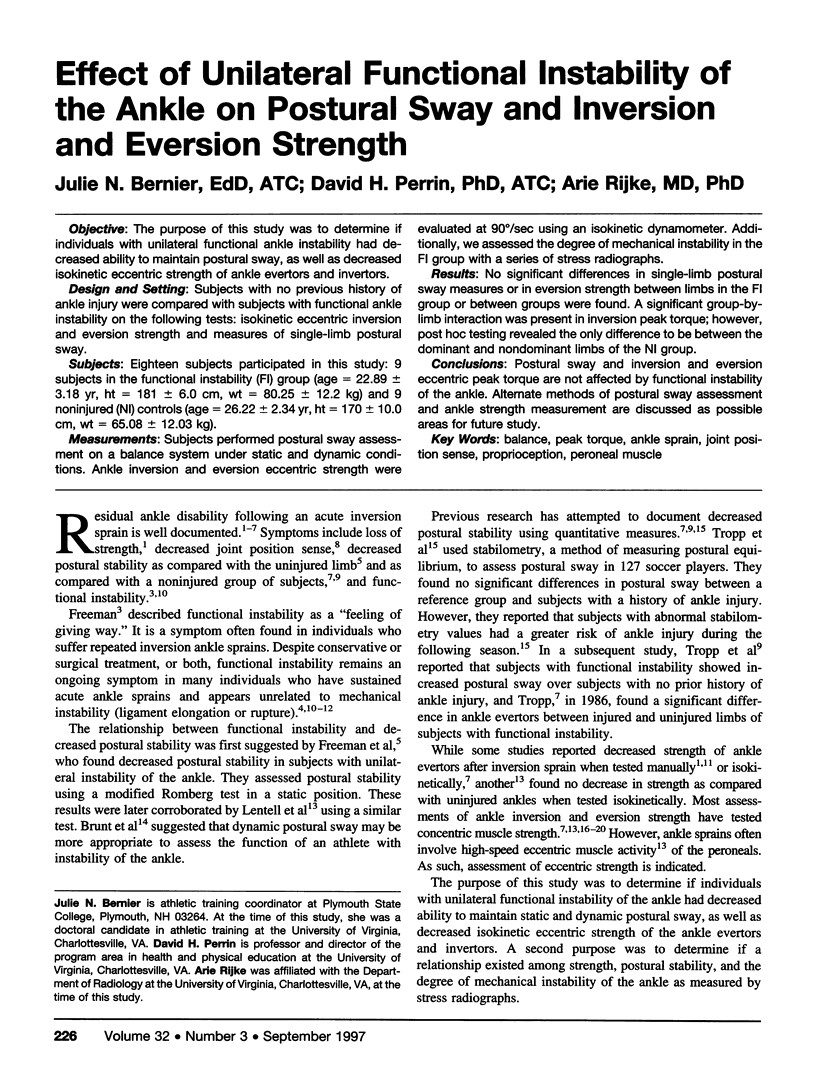
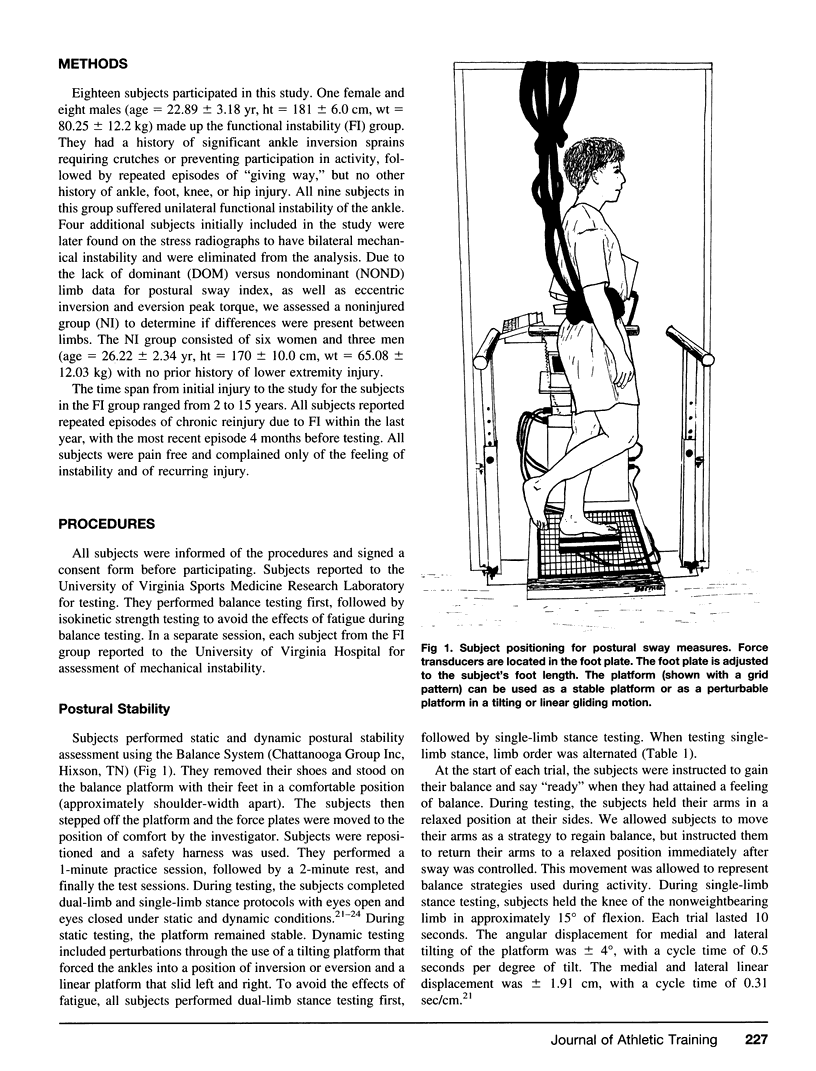
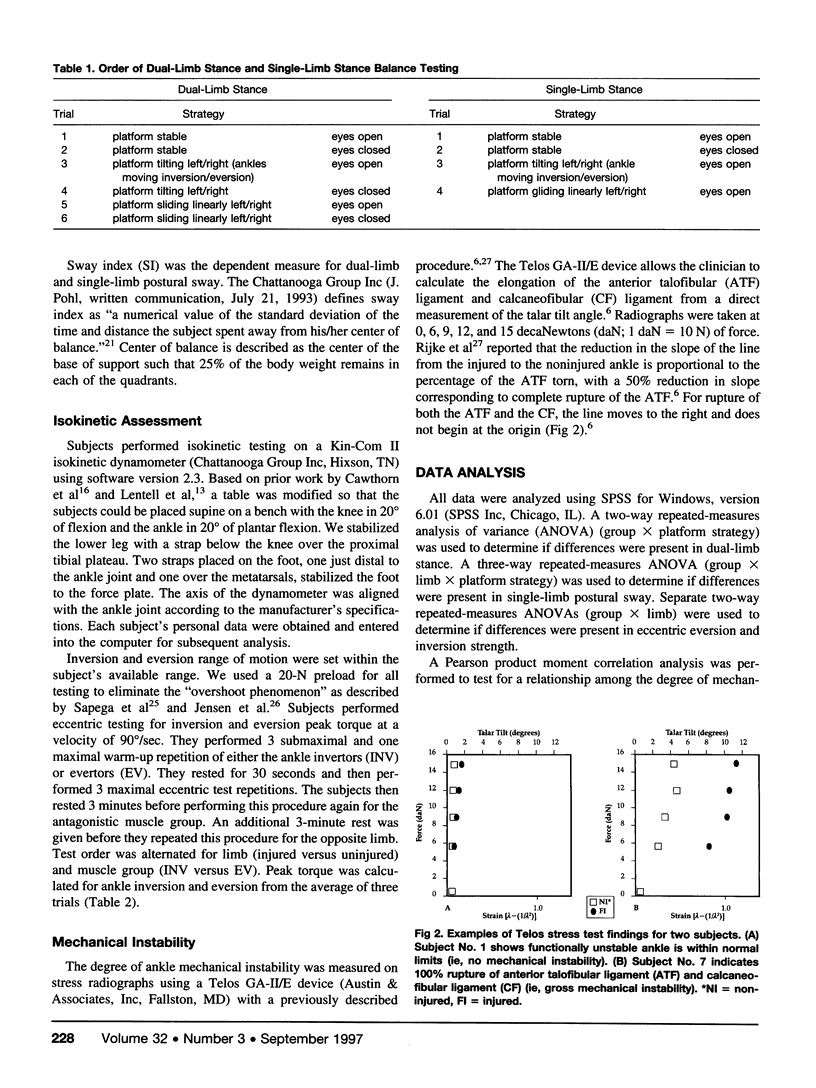
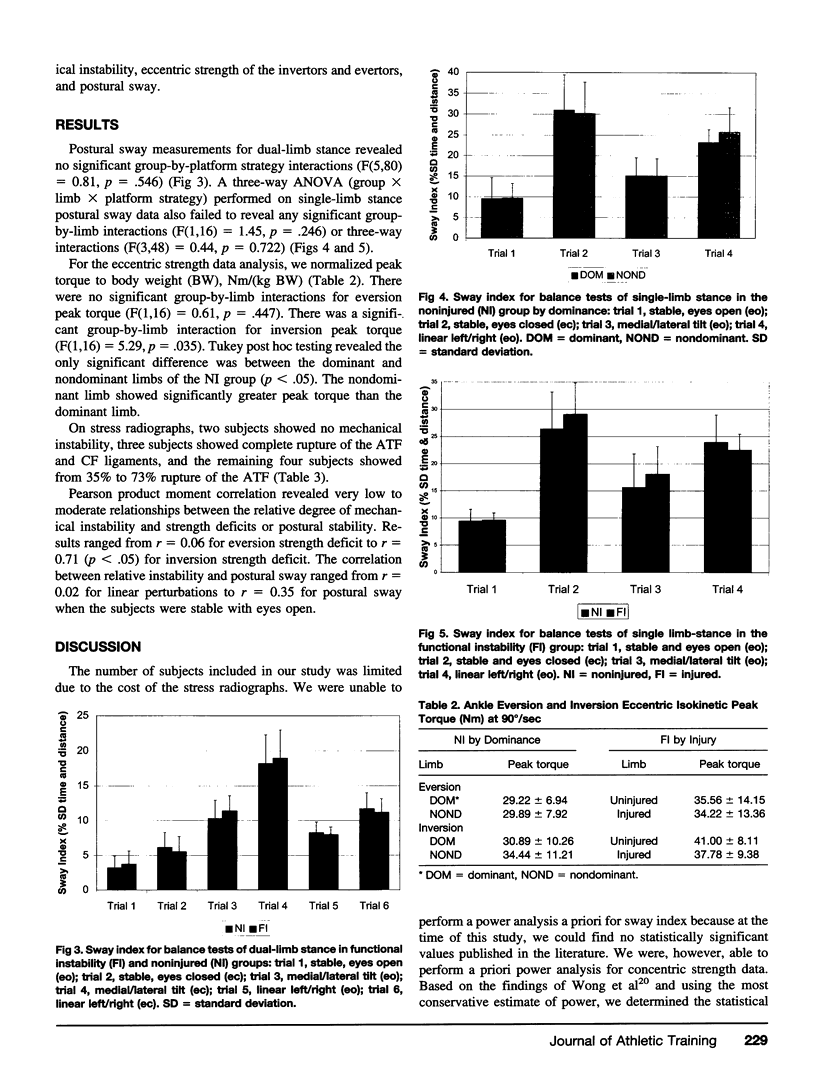
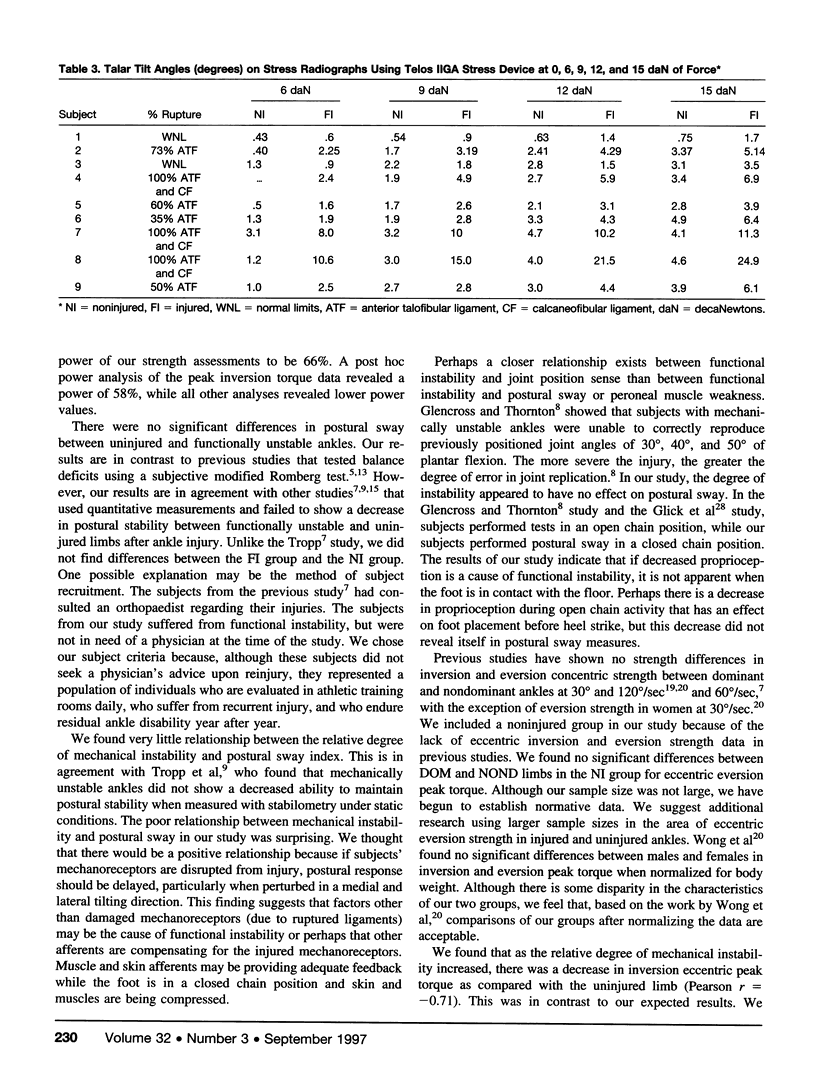
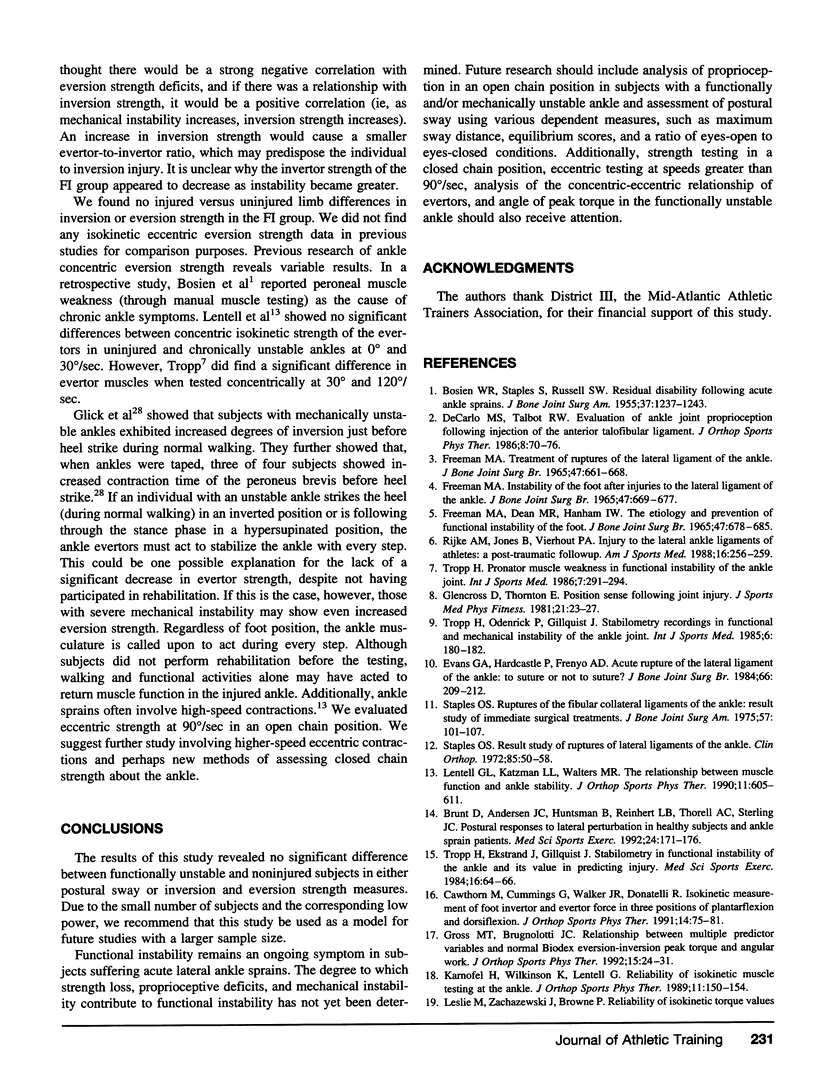
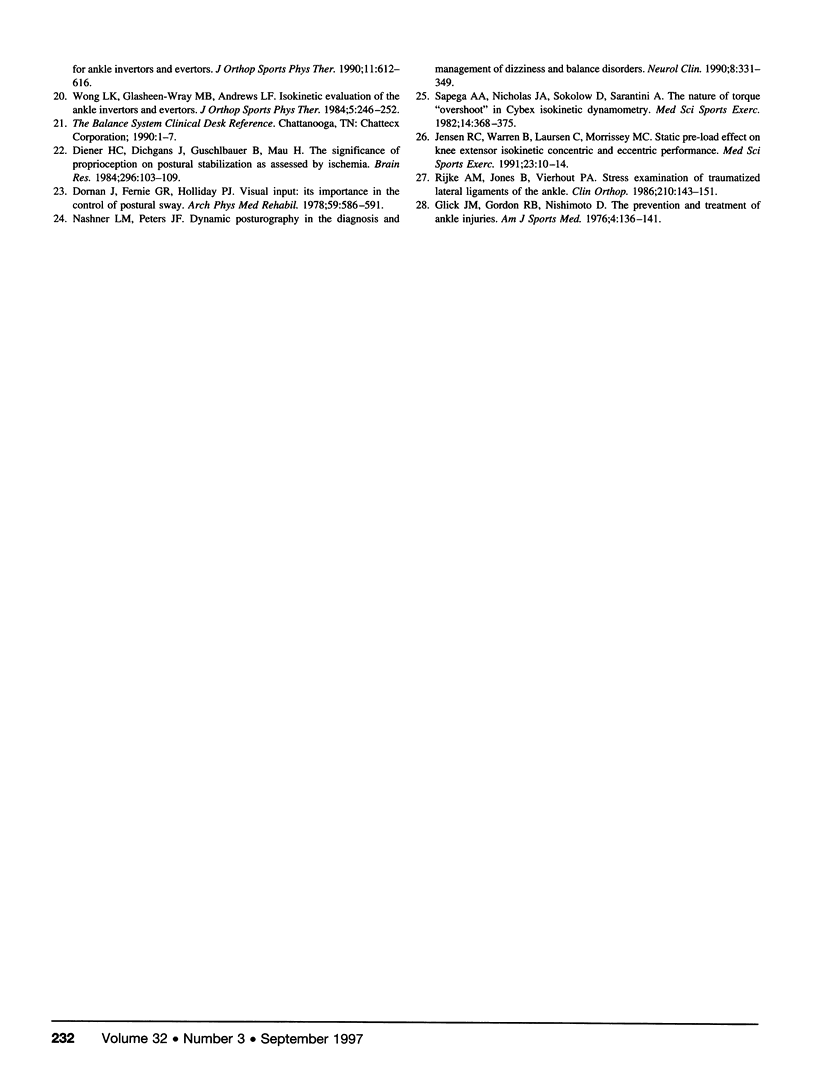
Images in this article
Selected References
These references are in PubMed. This may not be the complete list of references from this article.
- BOSIEN W. R., STAPLES O. S., RUSSELL S. W. Residual disability following acute ankle sprains. J Bone Joint Surg Am. 1955 Dec;37-A(6):1237–1243. [PubMed] [Google Scholar]
- Brunt D., Andersen J. C., Huntsman B., Reinhert L. B., Thorell A. C., Sterling J. C. Postural responses to lateral perturbation in healthy subjects and ankle sprain patients. Med Sci Sports Exerc. 1992 Feb;24(2):171–176. [PubMed] [Google Scholar]
- Diener H. C., Dichgans J., Guschlbauer B., Mau H. The significance of proprioception on postural stabilization as assessed by ischemia. Brain Res. 1984 Mar 26;296(1):103–109. doi: 10.1016/0006-8993(84)90515-8. [DOI] [PubMed] [Google Scholar]
- Dornan J., Fernie G. R., Holliday P. J. Visual input: its importance in the control of postural sway. Arch Phys Med Rehabil. 1978 Dec;59(12):586–591. [PubMed] [Google Scholar]
- Evans G. A., Hardcastle P., Frenyo A. D. Acute rupture of the lateral ligament of the ankle. To suture or not to suture? J Bone Joint Surg Br. 1984 Mar;66(2):209–212. doi: 10.1302/0301-620X.66B2.6368563. [DOI] [PubMed] [Google Scholar]
- Freeman M. A., Dean M. R., Hanham I. W. The etiology and prevention of functional instability of the foot. J Bone Joint Surg Br. 1965 Nov;47(4):678–685. [PubMed] [Google Scholar]
- Freeman M. A. Instability of the foot after injuries to the lateral ligament of the ankle. J Bone Joint Surg Br. 1965 Nov;47(4):669–677. [PubMed] [Google Scholar]
- Freeman M. A. Treatment of ruptures of the lateral ligament of the ankle. J Bone Joint Surg Br. 1965 Nov;47(4):661–668. [PubMed] [Google Scholar]
- Glencross D., Thornton E. Position sense following joint injury. J Sports Med Phys Fitness. 1981 Mar;21(1):23–27. [PubMed] [Google Scholar]
- Glick J. M., Gordon R. B., Nishimoto D. The prevention and treatment of ankle injuries. Am J Sports Med. 1976 Jul-Aug;4(4):136–141. doi: 10.1177/036354657600400402. [DOI] [PubMed] [Google Scholar]
- Jensen R. C., Warren B., Laursen C., Morrissey M. C. Static pre-load effect on knee extensor isokinetic concentric and eccentric performance. Med Sci Sports Exerc. 1991 Jan;23(1):10–14. [PubMed] [Google Scholar]
- Nashner L. M., Peters J. F. Dynamic posturography in the diagnosis and management of dizziness and balance disorders. Neurol Clin. 1990 May;8(2):331–349. [PubMed] [Google Scholar]
- Rijke A. M., Jones B., Vierhout P. A. Injury to the lateral ankle ligaments of athletes. A posttraumatic followup. Am J Sports Med. 1988 May-Jun;16(3):256–259. doi: 10.1177/036354658801600310. [DOI] [PubMed] [Google Scholar]
- Rijke A. M., Jones B., Vierhout P. A. Stress examination of traumatized lateral ligaments of the ankle. Clin Orthop Relat Res. 1986 Sep;(210):143–151. [PubMed] [Google Scholar]
- Sapega A. A., Nicholas J. A., Sokolow D., Saraniti A. The nature of torque "overshoot" in Cybex isokinetic dynamometry. Med Sci Sports Exerc. 1982;14(5):368–375. [PubMed] [Google Scholar]
- Staples O. S. Result study of ruptures of lateral ligaments of the ankle. Clin Orthop Relat Res. 1972;85:50–58. doi: 10.1097/00003086-197206000-00011. [DOI] [PubMed] [Google Scholar]
- Staples O. S. Ruptures of the fibular collateral ligaments of the ankle. Result study of immediate surgical treatment. J Bone Joint Surg Am. 1975 Jan;57(1):101–107. [PubMed] [Google Scholar]
- Tropp H., Ekstrand J., Gillquist J. Stabilometry in functional instability of the ankle and its value in predicting injury. Med Sci Sports Exerc. 1984;16(1):64–66. [PubMed] [Google Scholar]
- Tropp H., Odenrick P., Gillquist J. Stabilometry recordings in functional and mechanical instability of the ankle joint. Int J Sports Med. 1985 Jun;6(3):180–182. doi: 10.1055/s-2008-1025836. [DOI] [PubMed] [Google Scholar]
- Tropp H. Pronator muscle weakness in functional instability of the ankle joint. Int J Sports Med. 1986 Oct;7(5):291–294. doi: 10.1055/s-2008-1025777. [DOI] [PubMed] [Google Scholar]





